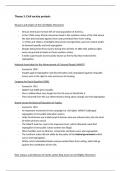Summary
Summary History Theme 3: The Civil Society Protest
- Module
- Institution
These notes come from myself, who passed matric of 2023 with an overall average of 87% in each subject i took. Notes about the civil society protest involving Martin Luther King JR., Women’s Liberation Movement and SNCC, Malcom X and NAACP. The main theme is African American starting protests a...
[Show more]



